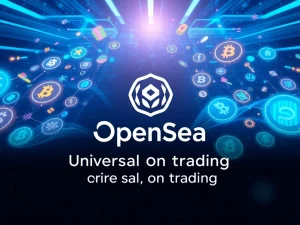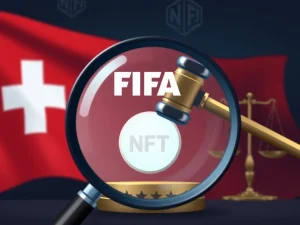Memecoins’ Remarkable Surge: Navigating NFT Regulatory Clarity in the Evolving Crypto Market

The cryptocurrency landscape is undergoing a dramatic transformation, with memecoins asserting a surprising dominance and non-fungible tokens (NFTs) grappling with an intricate web of regulatory challenges. For anyone invested in or curious about the future of digital assets, understanding this evolving dynamic is crucial. From internet jokes turning into multi-billion dollar phenomena to unique digital collectibles facing legal ambiguities, the crypto market is a fascinating arena of innovation and uncertainty.
Memecoins vs. NFTs: Decoding the Core Differences
At the heart of the current crypto narrative lies the fundamental distinction between memecoins and NFTs. While both have captured significant public and investor interest, their underlying structures and purposes diverge sharply. This differentiation is not merely academic; it has profound implications for investment strategies, taxation, and future regulation.
- Memecoins: The Social Phenomenon
- Nature: Fungible tokens, often created as humorous internet jokes or parodies. Think Dogecoin (DOGE) or Fartcoin (FARTCOIN).
- Utility: Typically lack inherent utility beyond community sentiment and social trends. Their value is largely driven by hype, social media virality, and celebrity endorsements.
- Tradability: Divisible and quoted in fractions (e.g., 0.0001 DOGE), similar to traditional cryptocurrencies.
- Regulatory View (often): Classified as collectibles by the SEC, subjecting them to a higher 28% capital gains tax by the IRS.
- NFTs: Unique Digital Ownership
- Nature: Non-fungible, meaning each token is unique and cannot be replaced by another identical token. They represent ownership of specific digital or physical items. Examples include Bored Ape Yacht Club (BAYC) collections.
- Utility: Offer diverse applications across art, gaming, identity verification, real estate, and more, representing actual ownership or access.
- Tradability: Traded as whole, unique units (e.g., #221 of a collection), not divisible. They lack standard token symbols.
- Regulatory View (often): Face ambiguous regulatory status, with enforcement actions often scrutinizing resale royalties as potential indicators of securities.
The Ascent of Memecoins: A Surprising Market Share
Despite their often-humorous origins, memecoins have cemented their position as a significant force within the broader crypto market. Data from FTSE Russell highlights this remarkable growth:
| Metric | December 2022 | December 2024 |
|---|---|---|
| Memecoin Market Cap Share | 1.24% | 2.5% |
This near-doubling of market share in just two years underscores a shift in investor appetite, even as major index providers like FTSE Russell continue to exclude NFTs from investable benchmarks due to their speculative nature and valuation complexities. Kristin Mierzwa of FTSE Russell points out that memecoins are evaluated via centralized exchange trades, offering a clearer valuation path compared to NFTs, whose values often depend on rare traits, celebrity ties, and illiquidity.
Navigating the Regulatory Labyrinth: Why is Regulatory Clarity So Elusive for NFTs?
While memecoins surge, NFTs find themselves in a complex regulatory quagmire. The recent passage of the GENIUS Act, the first U.S. federal law regulating stablecoins, has undoubtedly catalyzed broader crypto market growth, pushing digital asset valuations beyond $4 trillion. However, this clarity hasn’t extended uniformly across all asset classes.
President Donald Trump’s foray into crypto with his World Liberty Financial platform—launching a stablecoin (USD1), NFTs, and a memecoin (TRUMP)—has amplified public interest but also starkly highlighted the urgent need for clear definitions. The SEC’s stance on NFTs remains ambiguous, with enforcement actions often focusing on aspects like resale royalties as potential indicators of securities. This lack of regulatory clarity creates uncertainty for creators, investors, and developers, hindering mainstream adoption and innovation.
Investment Risks and Opportunities: A Tale of Two Digital Assets
Investing in digital assets requires a nuanced understanding of their inherent risks and potential rewards. The stark contrast between memecoins and NFTs exemplifies this.
- Memecoins: High Risk, High Reward?
- Shane Molidor of Forgd warns that memecoins often resemble gambling, driven primarily by hype and lacking long-term sustainability. Their volatility is legendary, and while they can offer explosive gains, they also carry significant risk of rapid devaluation.
- Sergio Hamza of Coincu suggests a future where memecoins could evolve into tools for financial independence, especially if paired with AI-driven automation. However, he cautions that current volatility and extractive incentives hinder their long-term viability.
- NFTs: Utility-Driven Potential
- In contrast, NFTs demonstrate concrete potential across various industries. From revolutionizing art ownership and gaming experiences to enhancing identity verification and even facilitating real estate transactions, their utility-driven nature offers a more stable investment thesis over time.
- William Quigley, co-founder of WAX and Tether, speculates that 2025 could mirror the 2021 NFT boom, suggesting a potential resurgence in the market, though this remains speculative.
Taxing Times: Navigating the Complexities of Digital Asset Taxation
Beyond market dynamics and regulatory clarity, tax considerations add another layer of complexity for investors in digital assets. The IRS’s 2023 guidance, for instance, imposes a 28% tax on collectible NFTs, a significantly higher rate than standard crypto assets. This highlights the need for investors to stay informed and seek professional advice.
Furthermore, cross-border implications complicate matters, as various countries apply differing tax treatments, including value-added taxes or even double taxation on digital assets. Granular assessments of tokenomics and marketing strategies are crucial for investors to navigate these intricate tax landscapes effectively.
The Broader Debate: Innovation Versus Regulation
The ongoing discourse surrounding memecoins and NFTs is emblematic of a broader tension within the crypto space: the push for innovation versus the imperative for regulation. While NFTs are increasingly adopted across diverse industries—from art to real estate—their utility-driven potential stands in stark contrast to memecoins’ reliance on social virality and speculative trading.
As the SEC continues to grapple with defining NFTs as securities, the onus is on investors to conduct thorough due diligence. Understanding the fundamental differences, market drivers, and evolving regulatory frameworks for these distinct digital assets is paramount for making informed decisions in this rapidly evolving crypto market.
The journey of memecoins from niche internet jokes to significant market players, alongside the persistent quest for regulatory clarity for NFTs, defines a pivotal moment in the evolution of digital assets. As the crypto market matures, the interplay between innovation, community sentiment, and regulatory oversight will continue to shape its future, demanding vigilance and adaptability from all participants.
Frequently Asked Questions (FAQs)
Q1: What is the primary difference between memecoins and NFTs?
The primary difference lies in their fungibility and utility. Memecoins are fungible (interchangeable) tokens, often created for humor or social trends, lacking inherent utility beyond speculation. NFTs are non-fungible (unique) tokens representing ownership of specific digital or physical assets, offering diverse utilities in art, gaming, and identity verification.
Q2: Why are memecoins seeing such a significant surge in market cap?
Memecoins’ surge is largely driven by social media hype, community engagement, celebrity endorsements, and their potential for rapid, speculative gains. Their accessibility and low entry barrier also attract new investors to the crypto market.
Q3: What are the main regulatory challenges facing NFTs?
NFTs face ambiguous regulatory status, particularly concerning whether they should be classified as securities. Regulators like the SEC often scrutinize aspects like resale royalties, which can imply an expectation of profit from others’ efforts, potentially triggering securities laws. This lack of clear guidance creates uncertainty for the industry.
Q4: How does the IRS tax memecoins and NFTs differently?
The IRS often classifies memecoins as general cryptocurrencies or commodities, subject to standard capital gains tax rates depending on holding period. However, NFTs, especially those deemed “collectibles” (like digital art), can be subject to a higher 28% capital gains tax rate, which is typically reserved for physical collectibles.
Q5: What are the long-term investment prospects for memecoins versus NFTs?
Long-term prospects vary significantly. Memecoins are generally considered high-risk, speculative investments driven by hype, with sustainability concerns. NFTs, however, are seen to have more long-term potential due to their utility in various industries (art, gaming, identity, real estate) and their representation of unique digital ownership, though their market can also be volatile.









